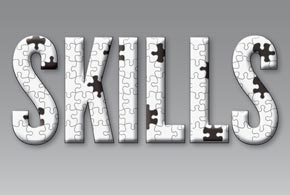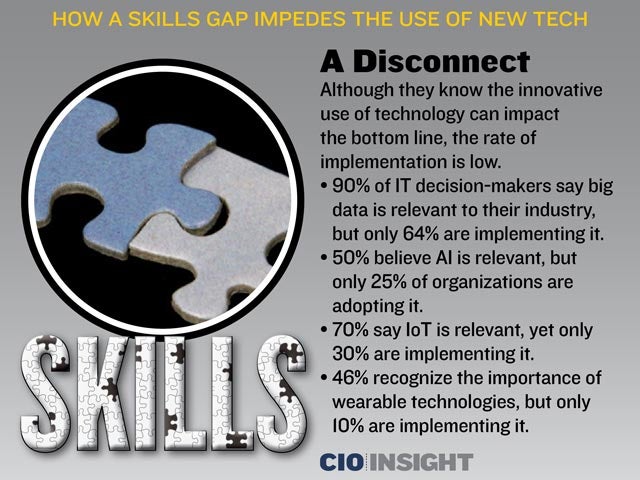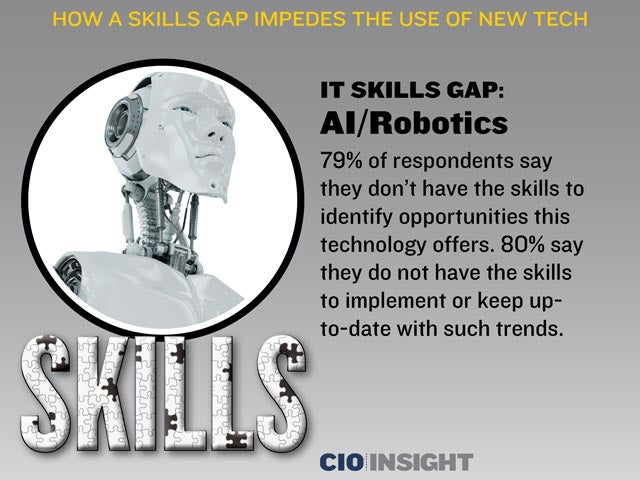
How a Skills Gap Impedes the Use of New Tech
 How a Skills Gap Impedes the Use of New Tech
How a Skills Gap Impedes the Use of New Tech
A skills gap in IT workers is slowing the implementation of new technologies such as the IoT and AI, but third-party partnerships could help turn that around.
 Importance of Technological Trends
Importance of Technological Trends
78% of respondents say it is vital or very important to keep up with the latest tech trends. 88% agree financial gains can be made by responding to IT trends within their business, and 86% say they can gain competitive advantage by doing so.
 A Disconnect
A Disconnect
Although they know the innovative use of technology can impact the bottom line, the rate of implementation is low. 90% of IT decision-makers say big data is relevant to their industry, but only 64% are implementing it. 50% believe AI is relevant, but only 25% of organizations are adopting it. 70% say IoT is relevant, yet only 30% are implementing it. 46% recognize the importance of wearable technologies, but only 10% are implementing it.
 Barriers to Implementation
Barriers to Implementation
Management pushback: no perceived business case and concerns over cost fog discussion. Risk aversion: many businesses look to their competitors to test technologies first. Lack of vision: 75% of respondents claim their organization keeps abreast of trends, but later questions belie this—many businesses have neither the skills to identify opportunities nor to implement and manage the technologies.
 Expectations for the Cloud
Expectations for the Cloud
One-third of respondents believe key tech advances will be implemented in their industry within the next 12 months, including cloud-based solutions. Contrary to analysts’ predictions, 34% think it will happen within the next five years.
 Expectations for the IoT
Expectations for the IoT
90% of respondents say the IoT is more than a year away from providing a solution for their industry. 52% say IoT will be implemented in their industry within the next five years.
 Expectations for Big Data , 3-D Printing, AI and VR
Expectations for Big Data , 3-D Printing, AI and VR
46% of respondents say big data will be implemented in their industry within the next five years. 19% say they do not think 3-D printing will ever be ready for use. 15% say the same for AI and virtual reality.
 The Skills Gap: IoT
The Skills Gap: IoT
Only three in 10 respondents have implemented the IoT. 80% say they have neither skills to implement these technologies nor to keep up-to-date with them.
 The Skills Gap: Wearables
The Skills Gap: Wearables
Besides lack of skills, costs and staff privacy impede wearable implementation. 75% of respondents do not have the skills to implement wearables and 76% don’t have the skills to keep up with the trend.
 The Skills Gap: Big Data
The Skills Gap: Big Data
90% of decision-makers say big data is relevant to their industry. 66% say they don’t have the skills to implement big data.
 Skills Gap: AI/Robotics
Skills Gap: AI/Robotics
79% of respondents say they don’t have the skills to identify opportunities this technology offers. 80% say they do not have the skills to implement or keep up-to-date with such trends.
 Conclusion
Conclusion
The report concludes that third-party partnerships are essential to avoid being left behind and to instead grasp the full potential of technological advancements.